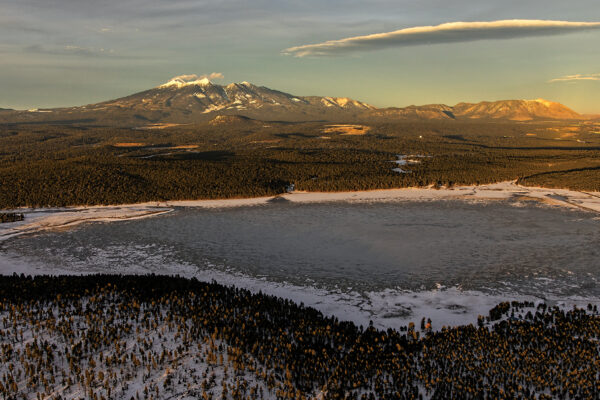For as long as humans have inhabited our corner of Arizona, their necks have been craned to the sky, gazing at the stars. Look at the pictographs of animals and hunters at the Palatki Heritage Site southwest of Sedona, and you’ll see an image that many believe to be a star; images of sun- and moon-like objects can be found at rock art sites all around the Verde Valley. To the north, the Hopi, believed to be descendents of the Sinagua people that populated the Verde Valley, tell a story about a boy who creates the Milky Way in order to climb up to the sun.
In Sedona and the surrounding areas today, the fascination with the heavens continues, and our night sky is uniquely suited to stargazing. Want to join the fun? On the following pages, we’ll introduce you to local astronomy clubs and two spots all stargazers should know: Lowell Observatory in Flagstaff and Meteor Crater just east of Flagstaff. And if all the talk about celestial bodies inspires you to plan your own star party, meet the man behind Evening Sky Tours, which will provide the telescopes and the astronomers if you provide the guests. Finally, learn about the International Dark Sky Association, Sedona’s lighting ordinance, and why it’s important to keep outdoor lighting to a minimum. Sedona may be hundreds of miles east of Hollywood but if we preserve our dark skies, we’ll continue to see more stars here than you’ll see in L.A. any night of the week.
Astronomers of the Verde Valley and Sirius Lookers
JD Maddy stands in the roll-off roof observatory at his home in Clarkdale, peering through one of three telescopes to watch a solar flare. He’s the president of the Astronomers of the Verde Valley, a family-oriented club for amateur stargazers, owns eight telescopes, takes “astronomy vacations,” and says Arizona has more “usable” skies than anywhere else.
“It’s the weather,” he says. “There really isn’t a bad month for viewing stars in the Verde Valley. Even during monsoon [season], most of the storms occur during the day.”
Dennis Young, president of Sirius Lookers, a Sedona-based astronomy club, agrees the weather is one reason Arizona has more telescopes than any other place in the country, but also cites the low-humidity, high-altitude locations and dark skies. “You can see galaxies with the naked eye” here, he says.
Astronomers of the Verde Valley (www.astroverde.org) has about 50 members who meet monthly at the Verde Valley Medical Center and hold monthly star parties at various locations. Sirius Lookers (www.siriuslookers.org) meets monthly at the Sedona Public Library and hosts many events – the club counts 20 members but Dennis says some club events have drawn several hundred people. The Verde Valley club’s favorite stargazing spots include Mingus Mountain, Two Trees on Forest Road 525, Beaverhead Flats Rd., and private land off Hwy 169 near the town of Cherry. Sirius Lookers also meets out at Two Trees but has traveled as far as Mt. Graham in southern Arizona near the New Mexico border and California.
Both clubs welcome experienced members as well as novices. Those serious about astronomy tend to be night owls – JD recommends starting after 10 p.m., but the best hours are between midnight and 4 a.m. “Heat radiating from the earth causes a shimmering effect when you look through the telescope and that’s usually gone” in the wee hours, he explains.
With the Verde Valley’s mild weather and location, you don’t even need a telescope to see many of the night sky’s fascinating nebulas, double stars, galaxies, meteors, and the Milky Way, which stretches from horizon to horizon after midnight.
The views of constellations and celestial objects change with the seasons – in summer, stargazers look more toward the center of the Milky Way at objects such as M13, a globular star cluster made up of an estimated 1 million stars that are 26,000 light years away. (The M refers to French comet hunter Charles Messier, who created a list of celestial objects that were not comets.) Also visible during summer months are M57, a ring nebula (a mass of gas and dust), which appears as a smoky circle, the Sagitarius star cloud, and the Andromeda galaxy.




